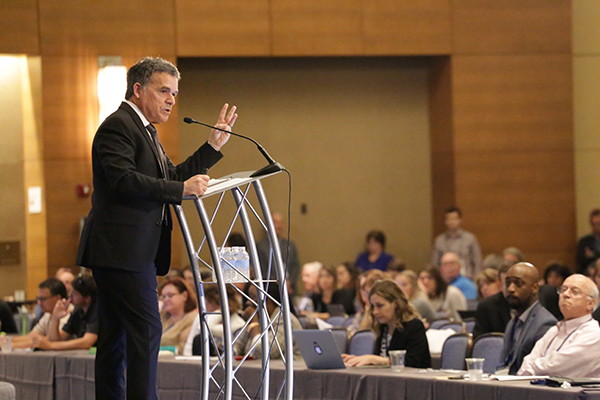EDGARTOWN, MA, January 22, 2020 – Innovative Publishing Company Inc., publisher of Food Safety Tech, has announced that Frank Yiannas, deputy commissioner for food policy and response at FDA, will serve as the keynote speaker for the 2020 Food Safety Consortium Conference & Expo on October 21. The Consortium is the industry’s leading food safety event for networking and educational opportunities, and takes place October 21–23 in Schaumburg, IL (just outside Chicago).
“At last year’s Food Safety Consortium, Frank Yiannas spoke about the ‘sea change’ happening at FDA and the increased efforts on the part of the agency to drive more transparency and traceability. We look forward to his insights, as well as learning more about FDA’s progress on its initiatives, especially the New Era of Smarter Food Safety,” says Rick Biros, president of Innovative Publishing Co., Inc. and director of the Food Safety Consortium Conference & Expo.
This year’s Food Safety Consortium Conference & Expo features three breakout tracks: Food Safety, chaired by Angela Anandappa, Ph.D., founding director of the Alliance for Advanced Sanitation; Food Integrity, chaired by Steven Sklare, president of The Food Safety Academy; and Food Defense, chaired by Jason Bashura, senior manager, global food defense at PepsiCo.
The call for abstracts is open until March 2, 2020.

About Food Safety Tech
Food Safety Tech publishes news, technology, trends, regulations, and expert opinions on food safety, food quality, food business and food sustainability. We also offer educational, career advancement and networking opportunities to the global food industry. This information exchange is facilitated through ePublishing, digital and live events.
About the Food Safety Consortium Conference and Expo
Food companies are concerned about protecting their customers, their brands and their own company’s financial bottom line. The term “Food Protection” requires a company-wide culture that incorporates food safety, food integrity and food defense into the company’s Food Protection strategy. The Food Safety Consortium Conference and Expo is an educational and networking event for Food Protection that has food safety, food integrity and food defense as the foundation of the educational content of the program. With a unique focus on science, technology and compliance, the “Consortium” enables attendees to engage in conversations that are critical for advancing careers and organizations alike. Delegates visit with exhibitors to learn about cutting-edge solutions, explore three high-level educational tracks for learning valuable industry trends, and network with industry executives to find solutions to improve quality, efficiency and cost effectiveness in the evolving food industry.
With the passage of the Farm Bill, there has been a great deal of interest from the food industry in cannabis-infused foods and beverages, which includes hemp and CBD. The Food Safety Consortium is co-located with The Cannabis Quality Conference & Expo, an educational and networking event for cannabis safety and quality solutions. Serving the Midwest market with a unique focus on science, technology and compliance, the Cannabis Quality Conference enables attendees to engage in conversations that are critical in finding solutions to improve regulatory compliance, quality, efficiency and cost effectiveness in a quickly evolving cannabis marketplace. Both conference programs run concurrently, thus, Food Safety Consortium registrants can attend any of the Cannabis Quality Conference presentations and vice versa. This year’s event takes place October 21–23 in Schaumburg, IL and is co-located with the Cannabis Quality Conference & Expo.












